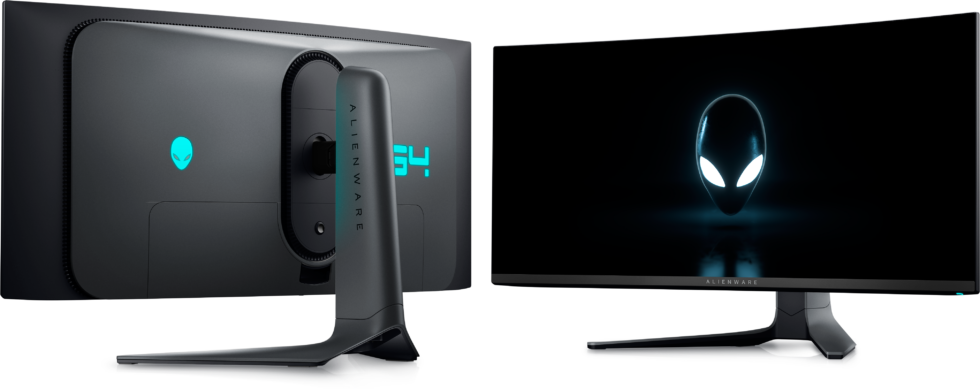
Alienware announced today a new QD-OLED monitor SKU that looks awfully similar to the Alienware AW3423DW released for $1,300 this spring. The AW3423DWF has many of the same specs but skips Nvidia G-Sync certification and hardware in favor of AMD's and VESA's open standards for fighting screen tears, while costing $200 less than its predecessor.
Like the AW3423DW, the AW3423DWF uses QD-OLED technology from Samsung. This is a form of OLED that uses a blue self-emitting layer as its light source, which goes through a layer of quantum dots. The primary goal is better color coverage, including more consistent colors across brightness levels, combined with the deep blacks and incredible contrast for which OLED displays are known.
The 34.18-inch AW3423DWF and AW3423DW's specs sheets match closely, including 3440×1440 resolution, an 1800R curve, 99.3 percent DCI-P3 and 149 percent sRGB color coverage, up to a 165 Hz refresh rate via DisplayPort and 100 Hz via HDMI 2.0, and 0.1ms gray-to-gray (GtG) response time.
But while the AW3423DW uses G-Sync Ultimate, which confirms 1,000 nits' brightness with HDR in addition to fighting screen tears when paired with an Nvidia GPU, the new AW3423DWF uses AMD's FreeSync Premium Pro and VESA's AdaptiveSync standards.

AMD's FreeSync Premium Pro works with AMD GPUs, including those within the latest Xbox and PlayStation consoles. The Premium Pro qualifier confirms the feature works with HDR (the monitor is VESA DisplayHDR TrueBlack400-certified) and adds low frame rate compensation, which displays frames multiple times to make up for when frame rates fall under the monitor's lowest supported refresh rate.
VESA announced its AdaptiveSync certification program in May. It includes testing for judder, dropped frames, and more strenuous GtG response time testing that looks at 20 GtG combinations.
VESA's AdaptiveSync requires functionality with refresh rates from at least 60–144 Hz (in the case of the AW3423DW, AdaptiveSync works a tup to 165 Hz) and a 5 ms GtG response time as per VESA's testing. Support with Nvidia, AMD, and Intel graphics cards, meanwhile, simplifies the compatibility question.
Even before VESA announced its AdaptiveSync program, the lines between G-Sync and FreeSync were already diminishing somewhat, with many FreeSync monitors also being able to run G-Sync without Nvidia hardware and, thus, maintain lower prices.
By skipping Nvidia certification or using the G-Sync module, Alienware has a $200 cheaper QD-OLED monitor with largely the same performance expectations. When VESA announced the AdaptiveSync performance tier (there's also a MediaSync one), the industry group acknowledged to Ars Technica that while this isn't its goal, the tiers could lead to the end of GPU-specific flavors of variable refresh rates (VRR).
Alienware also threw in a couple of extra features with the new AW3423DWF, including purportedly improved cable management and a five-way joystick that can bring up different image modes, including a new Creator Mode that switches the color gamut to sRGB and lets you adjust gamma. An Alienware rep confirmed to Ars Technica that in this mode, sRGB color coverage will drop to 100 percent, rather than the max of 149 percent.
Alienware also claims the new monitor will be easier to mount than the prior one, thanks to a slimmer profile. The AW3423DWF is 5 inches deep without the stand versus the AW3423DW's 5.4 inches.

With a 21:9 aspect ratio that lends to black bars when console gaming at 16:9 and HDMI 2.0 connectivity maxing out at 100 Hz at the monitors' max resolutions, neither QD-OLED display is the perfect fit for modern console gaming. However, the display should support VRR at up to 120 Hz on the Xbox Series X/S and PlayStation 5 at 2560×1440 resolutions.
Alienware will start accepting orders for the AW3423DWF this fall.
Ars Technica may earn compensation for sales from links on this post through affiliate programs.
Editor's note: This article originally stated that orders for the monitor would start on a specific date, but an Alienware representative reached out to Ars, saying that the company's no longer providing a specific date for taking orders. The article was also updated to specify the AdaptiveSync range and Creator Mode color coverage.
reader comments
74